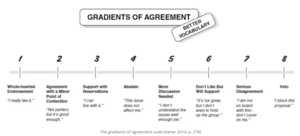Gradients of Agreement

A scale upon which to measure participants' levels of agreement with a given statement or course of action.
Goal
This tool supports inclusion in decision making by ensuring everyone has an opportunity to specify the level of their agreement or disagreement with a decision under discussion. It enables participants to express views in a more nuanced way than a mere "yes/no" vote.
Materials
Instructions
Before inviting to express gradients of agreement, the facilitator should make sure the group knows how much alignment will be required in order for the decision to go forward. Is this a situation in which we need everyone's full enthusiasm, or is a lukewarm reception enough?
Enthusiastic support is important when…
- There are high stakes, and the decision is important
- There is a long-term impact
- There is a tough problem
- There is high investment (including monetary and stakeholder buy-in)
- You need to empower group members.
In many situations, lukewarm support is all you need. Kaner (2014) wrote that lukewarm support is okay when….
- There are low stakes
- There is a short-term impact
- The decision is generally simple
- There is low investment (in monetary and stakeholder buy-in)
- The team only needs low autonomy, meaning not everyone needs to feel empowered.
Adapt the gradients to the specific situation, they don't have to be 8!
Participants can vote with hand signals (as in Fist-to-Five), by putting dots on the poster or in more sophisticated version, with Feedback Frames.
Online
The method can easily be adapted to online by using, for example:
- different emoji reactions to signify different gradients;
- a poll;
- virtual sticky notes on an online whiteboard.
Attachments
- gradients_kaner.png
Background
Kaner, S. (2014). Facilitator’s Guide to Participatory Decision-Making. Third edition, Jossey-Bass: San Francisco, California, United States of America.
For a complete overview of the method and some pointers, see this writeup by Hannah Love.
Author
Deborah Rim Moiso is an Endorsed Facilitator with the IAF – International Association of Facilitators and the current co-chair of the Italian IAF Chapter. She is also a content writer for SessionLab and a published author of a manual and deck of cards on facilitation available in Italian (Facilitiamoci! Prendersi cura di gruppi e comunità).
More about author